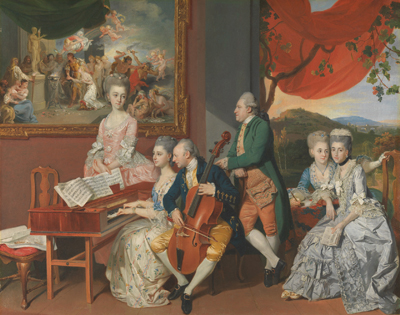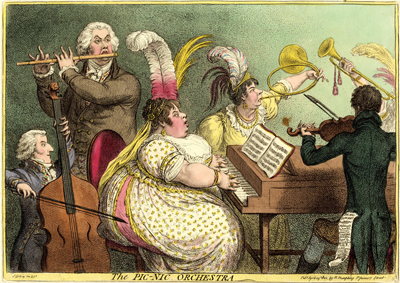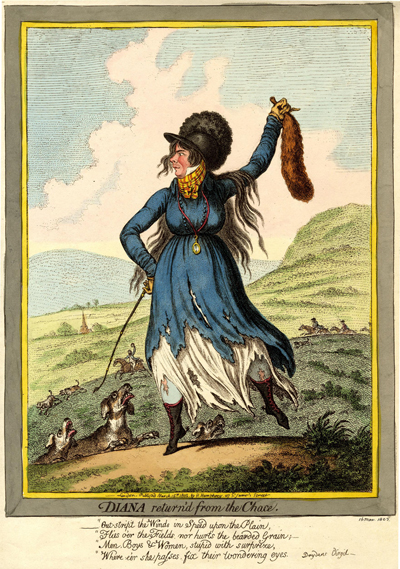The Pic-Nic Orchestra
One of the most important innovations in 18th century British painting was what was called the "conversation piece." It consisted of an informal portrait of friends or family engaged in a common activity, conversing together, examining art works, or playing music. William Hogarth, Arthur Devis, George Stubbs, and Johann Zoffany all produced examples of the genre. Sometimes, as in the portrait by Zoffany below, there was more than one activity going on simultaneously.

The Gore Family with George, third Earl Cowper [1775]
© Yale Center for British Art, Paul Mellon Collection
The Pic-Nic Orchestra is in effect, a wonderful parody of a musical coversation piece. It features some of the best known members of the Pic Nic Society, a group of aristocrats devoted to performing private musical and theatrical pieces for themselves and their friends. But every aspect of their portrayal—their size, their chosen instrument, the juxtaposition of the figures, and the playbill unfolding from the violinist's pocket—all provide some sort of satiric commentary.

© Trustees of the British Museum
The performers (from left to right) include the tiny Lord Mount Edgcumbe, (also known as Viscount Valletort) playing the cello. Juxtaposed with the very tall Lord Cholmondeley, the very wide Lady Buckinghamshire (whom he appears to be poking with his bow), and a very large cello, he looks, of course even smaller than he was. In fact, he seems to have been more of an opera fan than a cellist. He was the author of Musical Reminiscences of the Earl of Mount Edgcumbe, containing a list of the operas he is supposed to have heard from 1773 to 1823. And he was an avid actor, performing in a wide variety of roles in private theatricals before his Pic-Nic appearances.
Next is a very large Lord Cholmondeley, infamous for his numerous sexual conquests, playing upon the flute, an instrument sometimes associated with lechery. His sexual expoits were of course accepted as typical male behavior, but apparently an aristocrat playing the flute in public was a bridge too far. Here is an notice from the Morning Post Gazetteer from April 17, just a week before the appearance of the The Pic-Nic Orchestra.
We have waited some days in hopes of seeing a contradiction of that part of the official paper of the Pic-Nics, which says, Lord Cholmondeley played the flute in the orchestra of this Theatrical Society. So false a libel we have not lately seen published, or one tending so much to degrade the Peerage. An English Earl, one of our hereditary legislators; to assert that he would forget what is due to his character, step into an orchestra before a public-company, paying by subscription for admission: that he would put himself into this situation, and waste the breath that should be used in discussing our laws, to produce sounds from a piece of wood to tickle the ears of the tabbies! why, we are positively certain, if his Lordship were to complain to the House of Lords, they would vote the paragraph a high breach of their privileges, tending to bring their body into contempt, and would punish the author of it.
At the piano is the conspicuously rotund Albinia Hobart, Countess of Buckinghamshire, one of the founders of the Pic Nic Society. She had been involved in private theatricals for many years, appearing in a staged version of Fanny Burney's Cecilia as long ago as 1784,and memorably captured by Gillray in Enter Cowslip with a Bowl of Cream (1795) appearing in the role of a young maid from John O'Keefe's comic opera, The Agreeable Surprise.

© National Portrait Gallery, London
Next to her is Lady Salisbury, noted for her pack of hounds and love of fox hunting. She had been recently caricatured in Gillray's Diana Return'd from the Chace (March 16, 1802), and, more recently, in Blowing up the Pic Nics (April 1, 1802). Here she plays (appropriately) a hunting horn.

©Trustees of the British Museum
Next to her with his back to us playing a violin is supposedly Colonel Greville, the other principal founder of the society. Emerging from his pocket is the purported playbill for the evening. It includes imitations of birds, each one chosen by Gillray for its satiric appropriateness to the performer:
Nightingale by Lord C[holmondeley] for its nocturnal activities
Tom Tit Lord ME (Mount Edgecumbe) for its very small size
Jackdaw Gen'l G[reville] for its energy and inquisitiveness (?)
Screech Owl Lady B[uckinghamshire,] for the awful quality of its voice
Poll Parrot. . .
Sources and Reading
- Commentary from the British Museum on The Pic-Nic Orchestra.
- Draper Hill, Fashionable Contrasts, 1966, Pl. 97.
- "Conversation piece," Wikipedia
- "George Cholmondeley, 1st Marquess of Cholmondeley," Wikipedia
- "Richard Edgcumbe, 2nd Earl of Mount Edgcumbe," Wikipedia
- "Henry Francis Greville," Wikipedia
- "Albinia Hobart," Wikipedia
- "An Unconventional Marchioness: The Life of Lady Salisbury," All Things Georgian
- "The History of the Picnic," History Today
- Thomas Wright and R.H. Evans, Historical and Descriptive Account of the Caricatures of James Gillray #517.
- Thomas Wright and Joseph Grego, The Works of James Gillray, the Caricaturist; With the History of His Life and Times, p. 288.
Comments & Corrections
NOTE: Comments and/or corrections are always appreciated. To make that easier, I have included a form below that you can use. I promise never to share any of the info provided without your express permission.